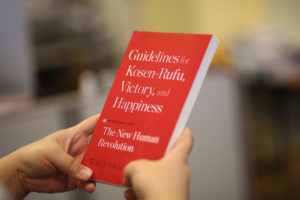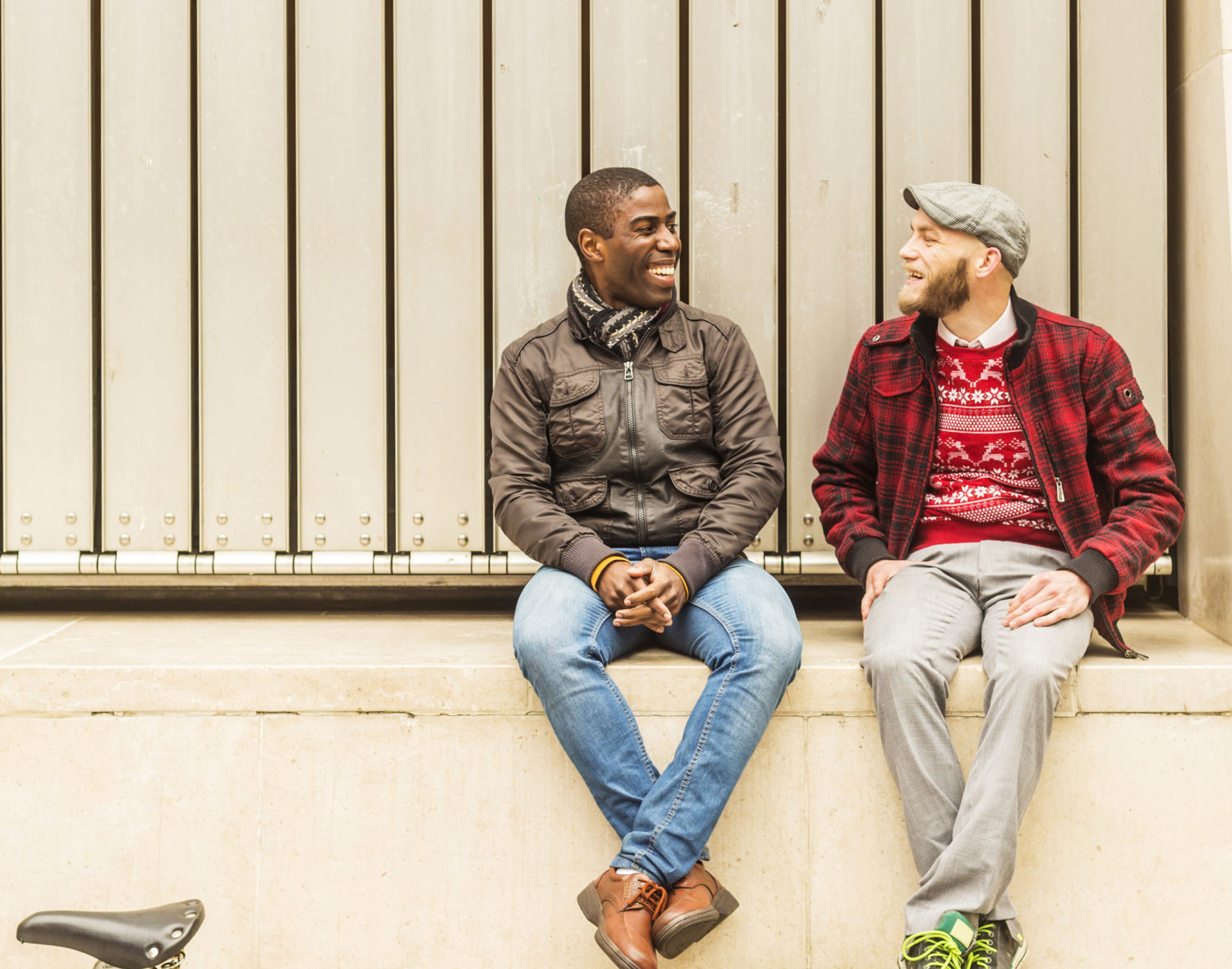As the SGI-USA starts a new era that is laser-focused on developing the district through personal encouragement and home visits, the World Tribune sat down with the SGI-USA leaders to discuss their personal experiences of being home visited, home visiting others and the lessons they’ve learned.
World Tribune: Can you share a memorable home visit from a senior in faith that helped you break through your challenges?
Adin Strauss (SGI-USA General Director): By spring 2003, I had been out of work for about nine months. I was married with two children, with no income for our household. I went through days of feeling a great lack of hope. What is my value if I can’t work? I thought.
It was then that a senior in faith came to visit me, along with his junior. I remember him carefully listening to me, then offering his praise and encouragement. He gave me a postcard that included a poem by SGI President Ikeda, which I still have to this day.
Reading Sensei’s encouragement on the postcard and being personally visited reminded me that, yes, I do have value as a human being even while being out of work. I found a job soon after, based on my renewed spirit!
Olivia Saito (SGI-USA Youth Leader): An important home visit came at a transitional time for me as well. When I moved back home after graduating from Soka University of America in 2010, I was lost and felt out of place.
A senior in faith came over, and we chanted Nam-myoho-renge-kyo together. I was nervous and didn’t know what to say at first, but I could sense her genuine care and concern for my life, so I began feeling comfortable enough to open up to her.
After simply listening for quite some time, she encouraged me to be true to myself and be confident in who I was, as opposed to answering to the expectations of others. My sister had just left home at the time, so I often felt that I was being compared to her. My leader gave me the confidence to clearly chant and discover my own identity.
Kevin Moncrief (SGI-USA Men’s Leader): A life-changing visit for me was in 1993, when I was living in Evansville, Indiana, working long hours at a job I was miserable at and making little money. There were almost no SGI members where I was living, and due to the distance and my work schedule, I was unable to attend activities. That’s when four seniors in faith from Louisville, Kentucky, drove nearly 150 miles to visit me. It was an all-day commitment for them, showing me what member care was all about.
Their presence was like sunshine warmly embracing my life, and it made me appreciate how wonderful our Soka Gakkai family is. I made a fresh determination to live based on faith and through becoming more internally driven, I would bring good fortune into my life. As a result, I found a new job opportunity that led me to California, where I still live today and joyfully participate in SGI-USA activities.
Ryo Kuroki (SGI-USA Young Men’s Leader): I, too, was moved by the extent my seniors in faith sought to encourage me. In 2003, I was in high school and was asked to support a large activity at the Hawaii Convention Center. I showed up late and missed my opportunity. I went home very discouraged and doubted that I would do any SGI activities moving forward.
That night, after the movement, two young men’s leaders came to my home. One of them was the SGI-USA Soka Group leader in charge of the entire behind-the-scenes movement.
Although not his fault, he took full responsibility and apologized that I couldn’t participate. He gifted me the Soka Group hat that was used for the festival. His care and sincerity allowed me to let go of my hesitations, and I determined to become more active. This visit became a turning point in my faith.
Later in my life, I was appointed the SGI-USA Soka Group leader and experienced the exhausting effort required to lead large movements. Looking back on that home visit, I realized how tired the senior in faith must’ve been. This ignited me with the determination to support others.
WT: Thank you for sharing your heartwarming experiences! What have you learned from your seniors in faith when they took you on home visits with them?
Adin: First thing, listen! It’s very important to listen before speaking or trying to encourage the other person. Another point my seniors taught me was that it’s always better to visit someone at their home, if possible. You can see the state of their altar, how and where they conduct their daily practice, and learn more about their personal life. In those cases, we should always be polite to roommates and family members. Those were key points I picked up.
Naoko Leslie (SGI-USA Women’s Leader): I love the practicality of those points. When I lived in Tokyo, my local chapter young women’s leader asked me to go on home visits with her. Since I was not very active in SGI activities, I didn’t know what we were doing, but we got on our bicycles and went to five homes.
From her I learned that visiting members together is so joyful. Even when the young women were not home, we wrote letters and she encouraged me in between the visits. Wonderful dialogue and inspiration can happen as we run for kosen-rufu together. For leaders, this is the best way to raise our juniors. Even one home visit together can make such a big difference in someone’s life.
Maya Gunaseharan (SGI-USA Young Women’s Leader): I also received great training, particularly on the importance of sharing our personal experiences related to the struggles of the person in front of us and speaking with the conviction that if we practice Buddhism correctly, we can transform all of our suffering into the greatest victory. Many of my leaders also studied together with their members on visits. This would become the impetus for the young women to develop their own foundation of study. I also learned the importanceof not making assumptions about the state of a member’s daily practice. My seniors would clearly ask young women if they were able to consistently do gongyo twice a day, for example.
Kevin: The point of not making assumptions was also a great lesson for me. My seniors taught me not to be judgmental, especially when our fellow members have made mistakes. When we speak from a perspective of judgement, we’re talking from a place of authority, but our perspective should be based on faith. How can we help our fellow members break through where they are right now? It’s an act of friendship and extending our humanity.
WT: What do you feel is the heart of home visits?
Ryo: For me, it is understanding how the young man lives his life, figuratively spending a day in his shoes, walking down the same streets as him. What books does he read? What music does he listen to? How is his family?
I once heard that when you go on a home visit, you should have the spirit to learn faith from the person you’re visiting. I like to ask a lot of questions: What made you start practicing Buddhism? What’s one experience that you can share with me? I always remind myself to conduct a home visit to learn from the members.
Naoko: In that sense, the spirit of respect is at the heart of home visits. Going to encourage someone at their home, for me, is an act showing ultimate respect for that person and their life so that they can enjoy the boundless benefits of the Law through connecting them to the Gohonzon and President Ikeda. Of course, we also experience the benefit of encouraging others.
Maya: I cannot agree more! When I was first appointed a local young women’s leader, I didn’t realize that my main role was to visit and encourage others. I was more focused on the logistical and administrative aspects of leadership, which are of course still important. But when I started to do more home visits and offer personal encouragement, my own personal practice completely shifted. Through the act of caring for one person and forging deep bonds with other young women, I developed a greater desire to break through in my own life. I realized home visits are essential to a correct Buddhist practice, because they encompass both practice for oneself and others.
Olivia: Yes! Unfortunately, meeting and encouraging one another is not a norm in our society. Rather, isolation is so prevalent today. Many youth disengage from the world or their environment when they begin to suffer. But isolation is the worst thing we can do.
Together, let’s make a fresh determination to create a groundswell of personal encouragement and home visits in America, with the heart of Buddhist compassion to relieve suffering and impart joy to our family, friends and fellow SGI members!

The Power of Personal Encouragement
The following excerpts are from Guidelines for Kosen-rufu, Victory, and Happiness—Selections From The New Human Revolution.
Ikeda Sensei: The source of all development in the realm of kosen-rufu lies in sharing the members’ sufferings, answering their questions to relieve them of any doubts, and making it possible for them to exert themselves in faith joyously, filled with confidence and hope …
We propagate Buddhism to lead others to happiness; in this respect, giving personal guidance in faith to new members is vital. As leaders, you must constantly ask yourselves: How many people in my district, group, or unit have stood up resolutely in faith and received benefit? This is a crucial point to remember. (p. 96)
I estimate that, now, four times as much guidance is given at meetings than is given to individuals personally. But if you make it your goal to reverse that ratio, you’ll be able to foster many more capable individuals and develop a stronger organization. Above all, you yourselves will be able to grow as leaders. (p. 98)
You are reading {{ meterCount }} of {{ meterMax }} free premium articles

